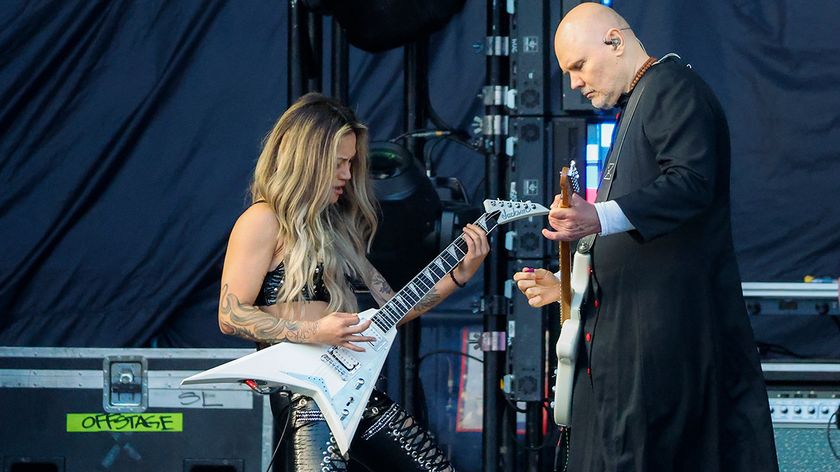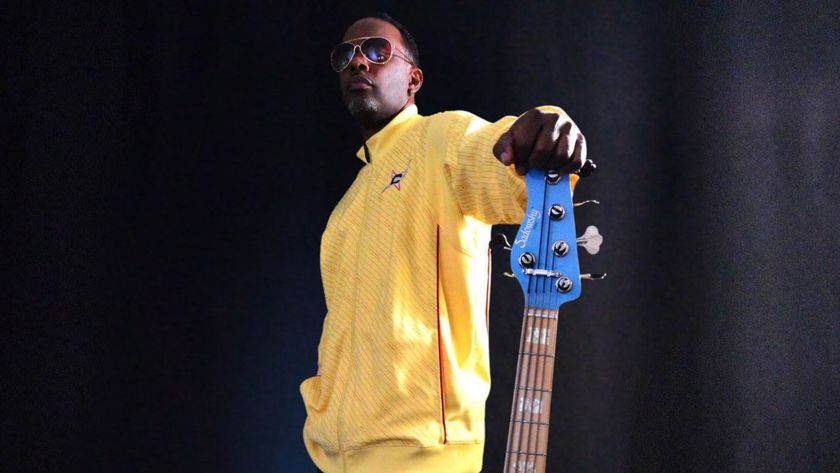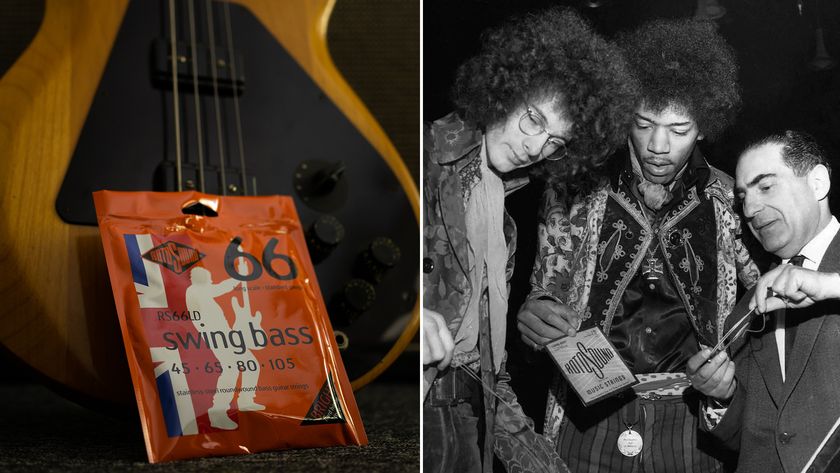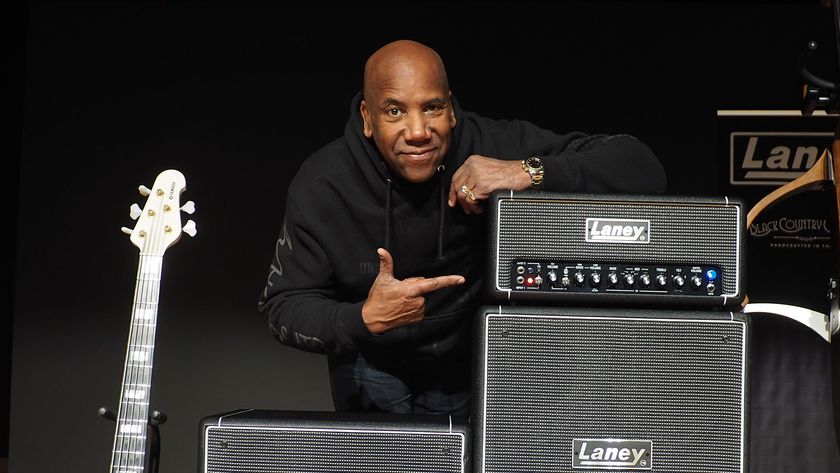“My tone is already destroyed by the time it gets to the amp”: Yard Act are redefining post-punk guitar with plugins and ‘cheapo’ gear – and they reckon a Squier Bullet Tele sounds great DI’d
In a radical new album, Yard Act are blurring the lines between post-punk and hip-hop. Guitarist Sam Shipstone reveals how it was made – with sampling, budget gear and an experimental approach to tone
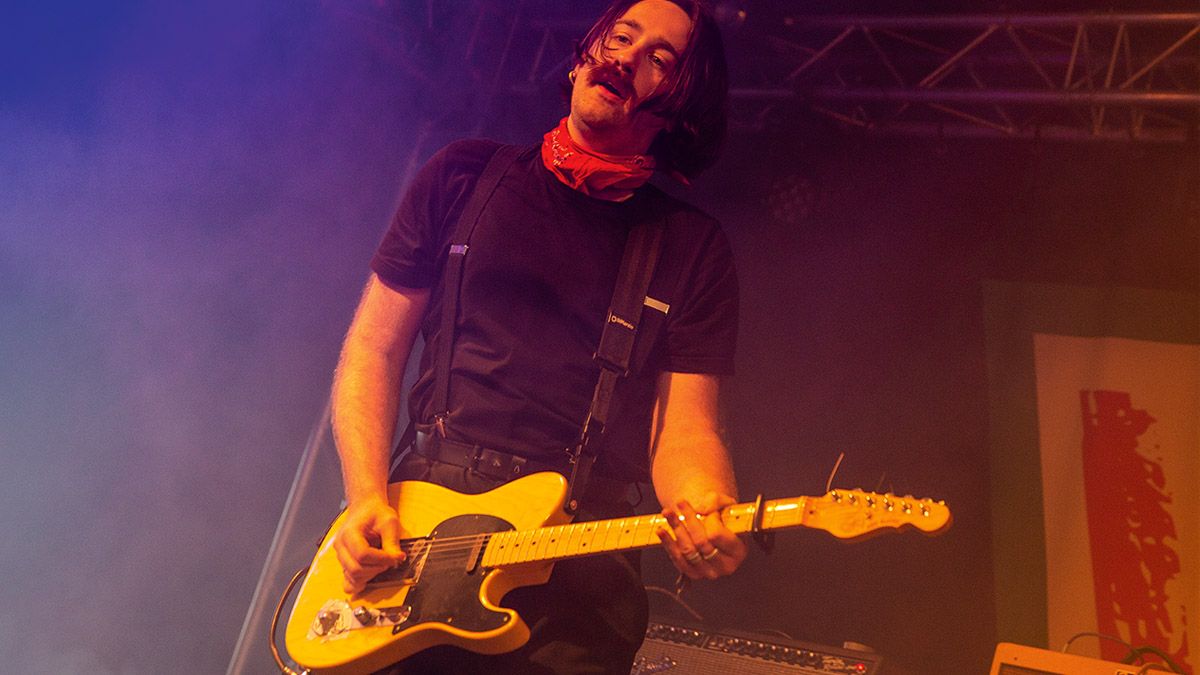
None of what you’ll hear on Yard Act’s thrilling and stylistically audacious sophomore album is what you could call conventional, but on occasion it borrows from convention, perhaps just to leave armchair musicologists with a little mud to grapple around in in search of a label to pin on them. Those we had are out of date.
Here we had the Leeds-based quartet down as a post-punk concern on the back of the urgent, wiry skronk of 2022 debut The Overload, and now along comes Where’s My Utopia? – all enigmatic and dynamic, the sound of a band whose sensibility has aggressively expanded, whose musical appetites have grown more adventurous from time spent together on the stage and in rehearsal rooms.
It’s not to say that it is wholly divorced from post-punk, but there is a more pertinent question to ask: is this a hip-hop record? Its production, overseen by Gorillaz’ drummer/producer Remi Kabaka Jr, bears some of the hallmarks of ’90s hip-hop, from the radio static breathing life into the album, and the vocal samples, down to the arrangements themselves.
One key track, Down By The Stream, is animated by a jacking beat that sounds as though it was engineered by Ced-Gee on an E-mu SP-1200 sampler, and is given muscle from Ryan Needham’s bassline. And what all this musical radicalism does is grant Sam Shipstone permission to subvert melody entirely and set loose a little anarchy on his guitar.
“When it started out with Down By The Stream it was completely different, and then we put on this really meaty bassline that James did, and then the drums changed, so this guitar part sounded even more atonal than when it started out,” he says, likening the track’s evolution to the philosophical thought experiment about the Ship of Theseus and the question of what’s left of an object’s identity when all its original parts have been replaced – an analogy that in and of itself that tells you we are dealing with something out of the ordinary.
“That was a slow development,” Sam says. “I didn’t intentionally write that guitar part like that. It just jarred against what that song became in a really good way.”
Down By The Stream, that’s literally chopped and sampled in parts, the way it jumps and moves. There are other tracks where we chopped it up like hip-hop in the same way
Many of the original parts on the album got cut up, sampled and reused. One of the beauties of modern recording is that you can move things around without the audience never knowing any different.
Get The Pick Newsletter
All the latest guitar news, interviews, lessons, reviews, deals and more, direct to your inbox!
“Down By The Stream, that’s literally chopped and sampled in parts, the way it jumps and moves,” he explains. “There are other tracks where we chopped it up like hip-hop in the same way. There’s a lot of sampling on this record.
“We would just sample things over and over and see if it fitted, and sometimes they fitted in a really poetic way. But then you can’t do a samples record anymore because it’s a nightmare – it’s so expensive. So we had to recreate everything, which was an absolute pain in the arse!”
There are other trace elements of hip-hop in the album’s opening track An Illusion, with its modulation between dark R ’n’ B menace and blissed-out hazy lounge jazz, and in the low-key triumphant We Make Hits, the track wheezes into life as though it had been ported onto vinyl and warped up to pitch as the turntable accelerates to 33 1/3 rpm.
Like hip-hop, the sound is similarly led by verse, vocalist James Smith’s freewheeling poetry steering the direction of the song. Indeed, Smith’s writing steers the direction of the writing process, leaving Shipstone in the position of composing to the vocals, and that has changed how he phrases his guitar parts.
It allows for an unorthodox conversational style that adds not only to the forward momentum of the material, as though all the instrumentation was in pursuit of an idea, but also a sense of freedom. Anything could happen.
“It’s a Yard Act thing,” Sam says, “and I think it comes from the fact that – unusually for a band – the vocals come really, really early in the demoing and often James writes so fast and so quickly. I think that allows for more of a conversation because you are not having to undo any of the work you are doing.”
But whether it could be classified as hip-hop seems besides the point. There are way too many other musical references to ever sustain the musicologist’s hip-hop line of enquiry. Yard Act reference sounds as though it were as easy as channel-surfing. Shipstone’s guitar gives Yard Act the untamed electricity of rock ’n’ roll, often dialling in a ghostly spaghetti western tone that could have come off the soundtrack to Alex Cox’s Straight To Hell [1987].
His playing also connects Yard Act to funk and soul, as when parking chord stabs on the backbeat on The Undertow, but there are also occasions when conventional licks would be an irrelevance, when using guitar as a texture maximises its impact.
Shipstone’s conversational style can make it sound as though he is playing on free time while his bandmates are punching the clock on the grid, and this sleight of hand sells us the illusion that these songs are being composed in the moment.
Again, the audience doesn’t need to be aware of just how difficult it was to put this together. Keep them on the other side of the curtain. They’re happy there. But the practising musicians need to know; they need to be aware that there can be all manner of restrictions when you write guitar to a vocal line, like when inspiration strikes and you compose a beast of a riff on 4/4 time only to find it doesn’t fit.
You can’t just do a circular riff because it might not meet up where you need it to
Riffs live and die by the rhythm, and how much space they’ve got, and that is just how it is. That is just one of the physical laws of music, and it is one of the lessons we can take from Yard Act and how Shipstone positions his guitar in the songwriting. “You can’t just do a circular riff because it might not meet up where you need it to,” he says.
As for tone, in a band like Yard Act it has to be moveable fast, reacting to the song as it develops. “I remember focusing on the final guitar riff on A Vineyard For The North and going through quite a few iterations,” Sam says. “Because when we first started that song it was a lot more open and jazzy – quite Radiohead: In Rainbows; the finale of that song.
“Then we put on quite a strong dance beat on and the guitar part didn’t work as well against it so we had to work for ages on that. We went through quite a lot of different effects, but it’s not got a lot of effects. We just did it on a 12-string, in fact. That was the solution to that in the end.
“That was quite hard work on the fingers, and doing that over and over on the 12-string I was like, ‘I really wish this wasn’t the solution!’ But it had this chime that just worked for that riff. We wanted it to come forward but we couldn’t find a way to do it until that guitar came into our hands.”
The production suggests that Where’s My Utopia? was an expensive record to put together, but that’s another trick on the ear. Some of what you are hearing was originally demo material recorded at home, with drummer Jay Russell operating the digital tools. Further sessions at Russell’s father’s studio in Kettering and at The Nave in Leeds would finish the record off.
I’m glad you said it sounded expensive, because it wasn’t, really!
“I’m glad you said it sounded expensive, because it wasn’t, really!” Sam laughs. “We hired a string section and a choir, but otherwise it wasn’t the most expensive record.”
And there was some super-budget gear on the recording, with Shipstone using Needham’s Squier Bullet Telecaster on Fizzy Fish. “When I put that on with headphones, that’s where that Fizzy Fish riff came from,” he says. “It sounded dead good DI’d. It’s a bit bizarre, that. It was surprisingly good for a cheapo guitar.”
Elsewhere, Sam stuck to his G&L ASAT on most of the tracks. The Leo Fender-designed second-generation T-style would rival a clawhammer for durability. It is a bright guitar so it typically gets paired with a Fender Blues DeVille tube combo amp when playing live.
“There’s something about the bassiness with that amp that complements the weediness of the tone,” he says. “And the tone is a bit hot, so it can end up sounding a bit farty and blurring out in a pleasing way, so the Blues DeVille copes with that in a nice way. I never like using an amp with a lot of gain on it because my tone is already destroyed by the time it gets to the amp. I need it to be transparent.”
When Sam last spoke to Total Guitar, he explained how Yard Act required less from his pedalboard than previous commitments with Hookworms. He had the Fulltone MOSFET FullDrive 2, an MXR EQ pedal, a Strymon Flint and a POG2 for The Overload.
This time out it is as though he has a ’board for daytime sounds and one for the nocturnal, like on Blackpool Illuminations, which sounds like it is haunted by old rock ’n’ roll, and could be read as a formalist commentary on the track’s subject matter, as though Shipstone is bringing a faded British seaside town to life through dark, subdued guitar tone.
He says it’s unconscious, but there are a number of occasions when the guitar tone sounds as if it is referencing the track thematically – like on Dream Job, which has this sort of ’80s studio guitar tone that somehow sounds cheap and high-class at the same time, and just right to complement Smith’s lyrics and flourish in two-and-a-half-minutes of sound that reverberates with the joie de vivre of Talking Heads.
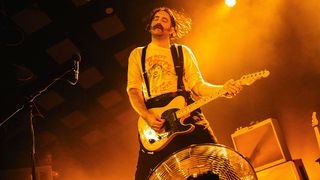
Recreating all of this live is going to be a challenge. It might require an expansion of the pedalboard. It might require more guitars. It might require Shipstone to make peace with the idea that, in a band like this, to perform this live, he might have to give in and let the pedal do the heavy lifting, to be the delay pedal operator if only just for one song.
“Quite a lot of those parts are going to have to remain texture – because I suppose in The Overload there weren’t really guitar parts like that,” he says. Still, he takes a bit of pleasure in creating a sound manually rather than using the pedalboard.
“I never use a delay live, but just to make things sound a little better studio-wise we often use a bit of [EHX] Memory Boy on a lot of things,” he says. “With one thing that I loved, the solo in Grifter’s Grief, when we took it to The Nave. Alex Greaves, one of the engineers there, asked, ‘Did you use one of those pitch-benders there?’ And I said, ‘No! We didn’t! I did it with my hands!’ I was so chuffed with that.”
Where’s My Utopia? did, however, involve a lot of plugins. The SketchCassette tape emulation plugin from Aberrant DSP was used so much that it became a running joke. “Every time that opened everyone in the room laughed,” Sam says. But its capacity to degrade the sound on samples and guitar contributes to the depth of field in the mix. So too does the mix of DI’d and re-amped guitar, with some of the leads recorded and left direct.
Who knows if it’s post-punk, hip-hop or alt-rock, but this is nose-to-tail a 21st-century album – literate, knowing, unorthodox, fourth-wall breaking, and facilitated by music’s digital revolution. “I was reflecting on how technology has allowed us to produce this record in this way,” Sam says. “At no other era in time would we have been able to produce a record like this.”
- Where’s My Utopia? is out now via Republic Records.
Jonathan Horsley has been writing about guitars since 2005, playing them since 1990, and regularly contributes to publications including Guitar World, MusicRadar and Total Guitar. He uses Jazz III nylon picks, 10s during the week, 9s at the weekend, and shamefully still struggles with rhythm figure one of Van Halen’s Panama.
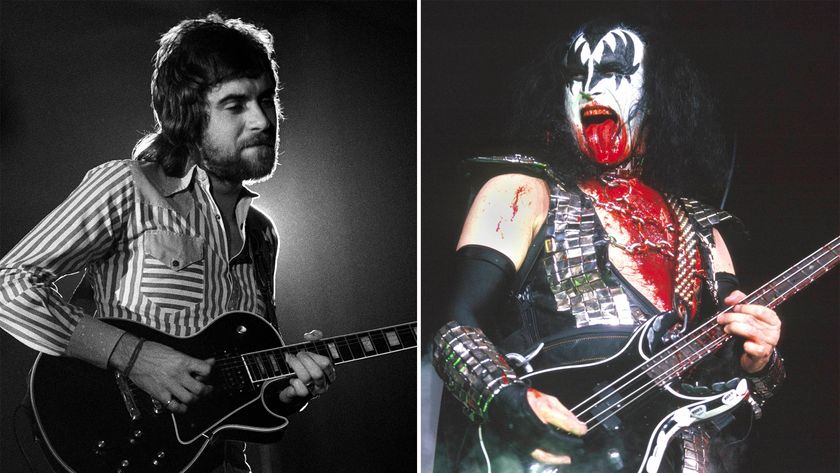
“I had to use the same microphone that Gene Simmons used with all the blood coming out of his mouth. Can you imagine that!”: Mick Rogers recalls Kiss supporting Manfred Mann's Earth Band in their early days

“Once Dave got his Roland Space Echo, it changed the vibe… that, and a lot of marijuana”: They inspired everyone from Oasis to the Smashing Pumpkins. Now English post-punk luminaries the Chameleons are back for more

